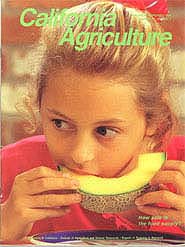


University of California
California Agriculture
|
|||
|
|||

How safe is the food supply?
Cover:
Kristina Clark noshes on a wedge of fresh cantaloupe. Photo by Jack Kelly Clark
January-February 1994
Volume 48, Number 1 News and opinion |
|||
|
University of California, 1301 S. 46th St., Bldg. 478 Richmond, CA
|